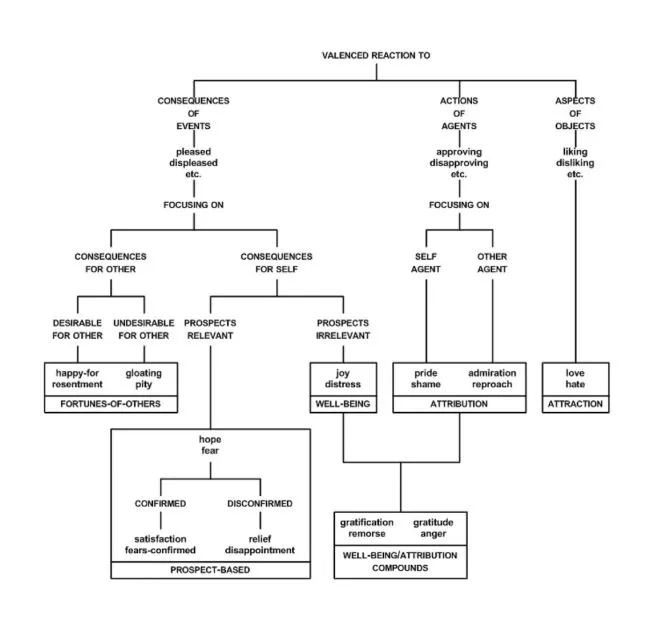[OCC Emotional Model]
Introduction:
Narrative is a complicated word. Some people believe that narrative could increase gaming experience while others say it is only a tainted game play. I won’t start a fuss about it, but I personally believe that the narrative holds a prospect in the game. This year GDC, Ken Levine, presented a new way of treating the narrative in a game referred as Narrative Lego. I see a big chance on it though it is still in early concept. A chance where narrative not only acting as decoration, but also a core of the game itself. His speech motivates me to do my own little research about narrative. Herewith, I will present what I’ve found so far.
In my opinion, the narrative is considered great when it triggers emotional effect to the player. To make it happens, the character in the game must possess emotion itself and delivers correctly to the player so they could feel the character’s emotion in order to create empathy towards the character. The first step in creating a great narrative is to know more about emotion, explore how many are they and how to elicit them. There are many concepts about emotion that we can use, but i’ll use OCC model because it describes how the emotion created in a structural way which makes it easier to understand (believe me, if you’re not into philosophy or psychology, read about emotion will push your brain off to the limit).
OCC structure, taken from The Cognitive Structure of Emotion, 1988
In OCC, it is said that a person can trigger an emotion by doing an appraisal towards event, action, or object. In a simple way, it goes like this: When an event happens to a person, he/she will appraise that event whether it is pleased or not then give a consequence to others or himself/herself. Afterwards, the effect from the other side will be recognized as desirable or not desirable. If it gives consequences to him/her, the consequence will give a prospect relevant to the person’s goal or not. After that consecutive appraisal, a person will elicit emotion according to the appraisal result. However it does not end here. If a person recognizes the action creating the event, he/she will appraise whether that action is approved or not and who did the action: himself/herself or another person. And if the person recognized it, people will apprise if he/she like the perpetrator or not.
Personal Reflection:
The article indroduced the OCC emotional model’s application in games. The author made many examples and analyzations based on the OCC model. He also analyzes how to make game narratives more realistic from the perspective of the OCC emotion model. I do agree with the author that it is great when the narrative triggers the player’s emotional impact. The good expression of emotions can resonate with players. In order to achieve this, game designers need to design the emotions of the characters in the game rationally: the characters need to have their own emotions and convey them correctly to the player. Then, the player can feel the character’s emotions and thus empathize with the character. The first step in creating a great narrative is to learn more about emotions, to explore how much of them there are and how to trigger them. I can get a clearer understanding of proper emotion theory and great narrative shaping through the OCC model presented in the article. Meanwhile, the examples in the article are very detailed and interesting. Thus, it is a good article on narrative for new game designers to read.
Reference:
Winanda, R. (2014, May 14). A better narrative using OCC emotional model. Game Developer. Retrieved January 23, 2023, from https://www.gamedeveloper.com/design/a-better-narrative-using-occ-emotional-model




